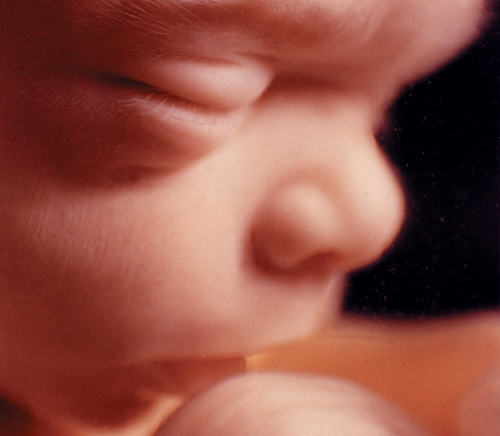You are 24 Weeks and 6 Days 106 days to go…
From this point onward, babies grow at an individual rate, which is largely influenced by their genes.
Your baby today
The nose is well defined and in addition to regularly swallowing
the amniotic fluid your baby is breathing it in and out through each
nostril. Just as adults do, your baby will tend to favor breathing more
through one nostril than the other.

The proportions of your baby’s body
are becoming much closer to those of a newborn baby. Up until the third
month, his head accounted for almost half of his overall length. Now
his head, trunk, and legs each account for a third. At birth your baby’s
head will still be large in proportion compared to an adult’s, but it
will be just a quarter of his overall length.
Still very skinny, your
baby is now starting to fill out more as fat reserves continue to be
laid down. Up until this point most babies are approximately the same
size and weight. Genetic and especially environmental forces
increasingly come into play, influencing how quickly your baby can grow
and whether his full growth potential is eventually reached.
Because different
babies increasingly vary in size from this stage of pregnancy,
ultrasound dating becomes less accurate at determining the number of
weeks you are into your pregnancy. The best time to date the pregnancy
is between 11 and 14 weeks, simply measuring top to bottom (the crown
rump length) . The 20-week scan (see Your 20-week Scan) also dates the pregnancy very accurately from the head and abdominal circumferences and the bone measurement in the leg.
If your first scan is at
this late stage, it is only possible to estimate roughly the stage of
pregnancy and age of the baby. It is never appropriate to change your
due date if an earlier, more accurate scan has been performed.
It’s all in the belly
The general story goes that if you’re carrying your baby low,
you’re having a boy, if you’re carrying high, then you’re having a
girl. The truth is, the way you carry is probably determined by the tone
of your abdominal and uterine muscles as well as the position of your
baby.
According to those
“old wives,” there are other physical clues: if you’ve gained weight on
your face and it’s round and full, you’re having a girl. If your right
breast is larger than your left, it’s a boy—and if your partner gains
weight, you’re “definitely” having a girl!
You are 25 Weeks Exactly 105 days to go…
You can expect to be subjected to a few unwelcome birth stories, whether you want to hear them or not!
Your baby today
Here the baby’s head is looking down toward the chest. The right
arm is bent at the elbow to lie across the neck, the left arm is only
just visible as it is partly in shadow, and finally the tip of a knee
can be seen tucked up just below the right forearm.

It appears to be a rite of passage
for some women to describe the birth of their babies in minute detail,
literally giving an hour-by-hour account. For these women, it appears to
be part of the recovery process and they like nothing better than a new
audience, and, especially, a woman who is pregnant for the first time.
So you’ll no doubt find yourself on the receiving end of a few birth
horror stories—sometimes from complete strangers!
These women may feel
it’s their duty to “warn” you about the “reality” of childbirth, and
what you should and shouldn’t do—for example, “definitely have an
epidural, otherwise the pain is horrendous.” Remember that every woman’s
experience is different and stay focused on your own birth plan.
Childbirth is undoubtedly difficult for some women, while others have
straightforward deliveries, without complications. Tell the story-teller
you’d rather not hear the gory details but promise to book a date for a
joint debrief once your baby is born!
Having a close female friend
or relative with you during labor, even if it’s only at home in the
early stages, may prove to be a great help to you and your partner.

Birth partners
The benefits of having a supportive birth partner are indisputable, so it’s a good idea to think about it now.
Research shows that
women who receive continuous emotional and physical encouragement
during labor are less likely to need pain relief or medical intervention
such as an epidural , assisted delivery , or cesarean , and should experience a shorter labor.
Women who feel their birth partner
was supportive are more likely to view their birth in a positive light,
and to take to motherhood and breast-feeding easily, and are less prone
to postpartum depression.
Your birth partner
doesn’t have to be the baby’s father (although he may be there as
well); in fact, studies indicate that a woman may do the job better. A
close female friend who’s had her own children could be ideal; your mom
is another option.
You could consider hiring a doula (see Mother’s help).
Mother’s help
The prospect of giving birth and then taking care of a newborn can be daunting. For some moms, hiring a doula is the perfect way to ensure a gentle progression from pregnancy to motherhood.
Doulas are women who
“mother the mother” by providing emotional and physical (but nonmedical)
support before, during, and after childbirth. Widespread research shows
that the presence of a doula can help you have a shorter, easier birth,
making it less likely that you’ll need pain relief or medical
intervention (including an epidural or cesarean).